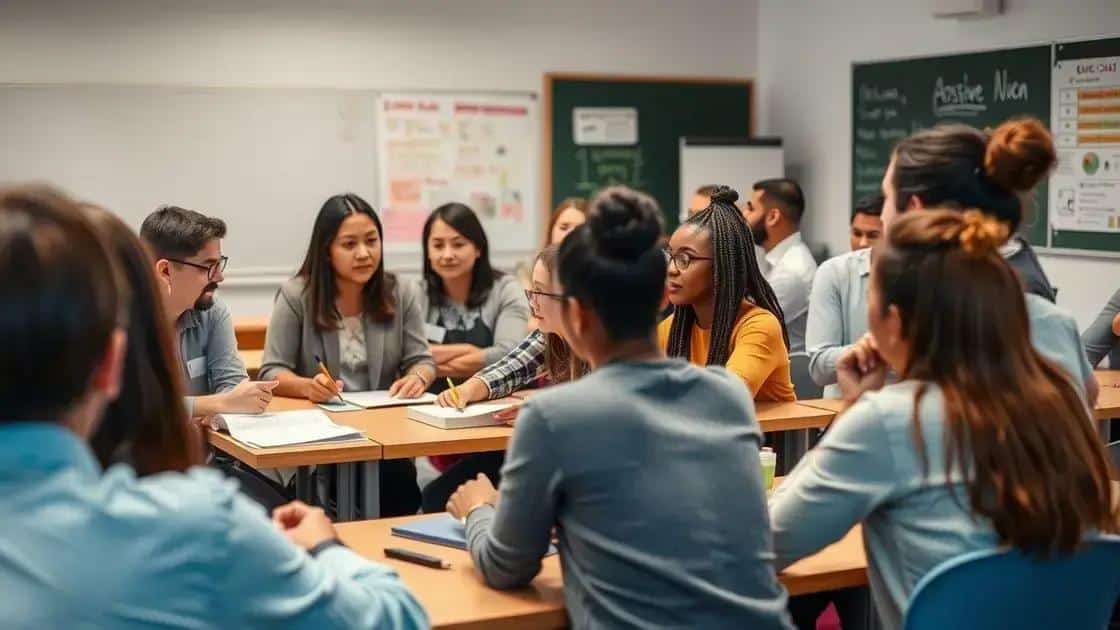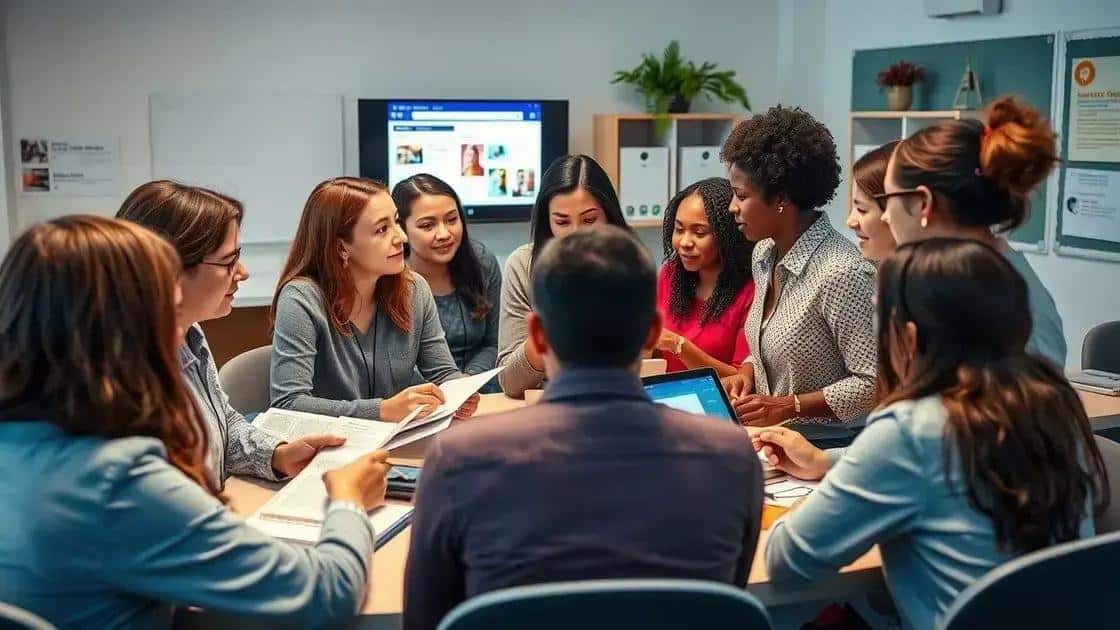Against teacher training initiatives: what you need to know

Engaging teachers in the training process enhances their skills and confidence through collaboration, feedback, and interactive methods, leading to improved educational outcomes for students.
Against teacher training initiatives, many educators are reconsidering traditional methods that may not address real classroom needs. Have you noticed how some training programs miss the mark? Let’s explore these dynamics together.
Understanding teacher training initiatives
Understanding teacher training initiatives is crucial for improving education. Many programs aim to enhance teaching skills, but their effectiveness can vary. By examining what these initiatives involve, we can identify their strengths and weaknesses.
The purpose of teacher training initiatives
These initiatives are designed to help teachers develop necessary skills and adapt to new teaching methods. They often focus on:
- Enhancing pedagogical strategies
- Integrating technology in the classroom
- Improving classroom management techniques
- Meeting the diverse needs of students
However, not all programs achieve their goals. It’s important to evaluate how well these initiatives align with actual classroom needs.
Challenges faced by teacher training programs
Many teacher training programs face significant challenges that can hinder their effectiveness. Some common issues include:
- Lack of practical application in real classroom settings
- Insufficient support from administration
- Inconsistent quality and content across different programs
- Limited engagement from participants
Addressing these challenges is vital for ensuring the successful development of teacher skills.
Moreover, educators often feel overwhelmed by the amount of training they receive without a clear connection to their day-to-day teaching. Therefore, a more tailored approach may be needed.
Improving teacher training initiatives
Enhancing these programs requires collaboration among educators, administrators, and policy makers. Focusing on tailored content that addresses specific needs can help. For instance, incorporating feedback from teachers about what is genuinely useful can lead to more relevant training.
Additionally, implementing mentorship programs may help bridge the gap between training and classroom implementation, providing ongoing support for new strategies and techniques.
The impact of ineffective training
The impact of ineffective training can be significant in the education sector. When teacher training programs do not meet the needs of educators, it can lead to various problems in the classroom.
Negative consequences of poor training
Inadequate teacher training can result in:
- Reduced classroom engagement from students
- Heightened stress and burnout among teachers
- Lower academic performance in students
- Wasted resources and time for schools
Each of these issues can create a cycle of frustration for both educators and students. When teachers feel unprepared, it directly affects their ability to teach effectively.
Long-term effects on educational outcomes
Over time, ineffective training can contribute to larger systemic problems within educational institutions. For instance, a lack of relevant skills can lead to:
- High turnover rates among educators
- Inconsistent teaching methods across classrooms
- Difficulty in implementing new curricula or technologies
This inconsistency can harm students’ educational experiences, making it harder for them to achieve academic success. Furthermore, when teachers leave the profession due to dissatisfaction, schools lose valuable knowledge and practices.
Additionally, ineffective training often fails to address the evolving landscapes of education. Teachers should be equipped with the latest strategies and knowledge to meet the diverse needs of their students.
Addressing the issues
To improve these outcomes, it’s essential for schools to continually evaluate their training programs. Feedback from teachers can guide necessary modifications, ensuring that training remains relevant and beneficial.
Moreover, incorporating ongoing professional development opportunities can keep teachers engaged and informed. By fostering a culture of learning, schools can enhance the overall quality of education.
Alternative approaches to teacher development

Alternative approaches to teacher development can provide fresh solutions to challenges in the education sector. As traditional training methods often fall short, innovative practices can enhance the skills and effectiveness of educators.
Mentorship programs
One powerful alternative is implementing mentorship programs. These programs pair experienced educators with newer teachers to foster growth. Benefits include:
- Personalized guidance on classroom management
- Support in developing lesson plans
- Encouragement to experiment with new strategies
Through mentorship, teachers can learn in a supportive environment, which boosts their confidence and effectiveness.
Collaborative professional learning communities
Another effective approach involves creating collaborative professional learning communities. In these groups, teachers work together to share practices and resources. This collaboration can lead to:
- Enhanced problem-solving skills
- Shared expertise and experiences
- Greater accountability among peers
Such communities allow teachers to learn from each other, driving improvement and innovation.
Additionally, providing opportunities for teachers to attend workshops and conferences can expose them to new ideas and practices. These events often cover cutting-edge educational research, allowing teachers to stay updated.
Online resources and self-directed learning
With advancements in technology, teachers can also benefit from online resources. Platforms offering webinars, online courses, and forums can enhance professional development. Self-directed learning enables educators to:
- Choose topics that interest them
- Learn at their own pace
- Access global networks of educators
These options can be tailored to individual needs, making development more effective.
As schools explore alternative approaches to teacher development, they can create a culture of ongoing learning. This not only helps educators grow but ultimately benefits students as well.
Real-world examples of educational success
Real-world examples of educational success serve as powerful illustrations of effective teaching strategies. By highlighting schools and programs that excel, we can learn valuable lessons about what works best in education.
Successful school programs
One remarkable example is the KIPP (Knowledge Is Power Program) network of charter schools. KIPP schools focus on high expectations and support for students, leading to:
- Higher graduation rates
- Improved test scores
- College readiness
This model emphasizes hard work and perseverance, demonstrating that with the right support, students can thrive.
Community-based initiatives
Another successful approach comes from community-based initiatives. Programs like Teach For America mobilize recent graduates to teach in under-resourced schools. This effort brings fresh energy and ideas to the classroom. The impact is often seen in:
- Increased student engagement
- Stronger community ties
- Innovative teaching methods
Such initiatives show how dedicated individuals can transform educational landscapes, even in challenging environments.
Moreover, the Mindfulness in Schools Project provides another creative example. This program implements mindfulness practices in classrooms, helping students manage stress and improve focus. Schools adopting this program report:
- Better emotional regulation among students
- Improved academic performance
- Enhanced teacher-student relationships
These examples highlight how diverse approaches can create significant positive outcomes in education, showing that innovation and adaptability are key to success.
Engaging teachers in the training process
Engaging teachers in the training process is essential for effective professional development. When educators feel involved, they are more likely to embrace new strategies and improve their teaching practices.
Creating a collaborative environment
One way to engage teachers is by fostering a collaborative environment. This involves encouraging open communication and collaboration among staff members. When teachers work together, they can:
- Share best practices and resources
- Support each other in implementing new ideas
- Provide constructive feedback
Such collaboration can lead to a more dynamic learning atmosphere, benefiting both educators and students.
Incorporating teacher feedback
Another effective strategy is incorporating teacher feedback into training programs. When educators have a voice in the development of their training, they feel more valued. Schools can achieve this by regularly soliciting input through surveys or focus groups. This approach allows for:
- Adjustment of training content based on needs
- Increased buy-in from teachers
- Creation of relevant and practical training modules
Moreover, understanding what teachers find helpful can lead to more effective outcomes.
Additionally, making professional development sessions interactive can enhance engagement. Techniques like group activities, role-playing, and hands-on learning should be included to keep teachers interested. These methods not only facilitate learning but also empower educators to try new methods in their classrooms.
Ongoing support and resources
Providing ongoing support and resources for teachers after training is essential. Access to materials, mentorship, and continuous professional development can foster growth. This support helps educators apply what they learn in real classroom situations, reinforcing their skills.
Ultimately, the goal is to create an experience where teachers feel invested in their professional development. Engaging them in this process leads to positive change in educational practices.
FAQ – Frequently Asked Questions about Engaging Teachers in the Training Process
Why is engaging teachers in training important?
Engaging teachers in training enhances their skills and confidence, leading to better educational outcomes for students.
How can collaboration among teachers improve training?
Collaboration allows teachers to share best practices, support each other, and create a more dynamic learning environment.
What role does teacher feedback play in training programs?
Teacher feedback helps shape training content to meet actual needs, increasing relevance and buy-in from educators.
What ways can schools make training more interactive?
Schools can use group activities, role-playing, and hands-on learning to make training engaging and effective for teachers.





